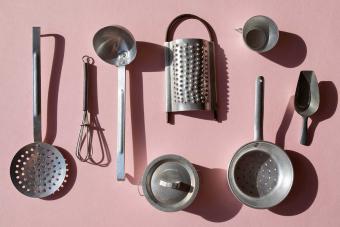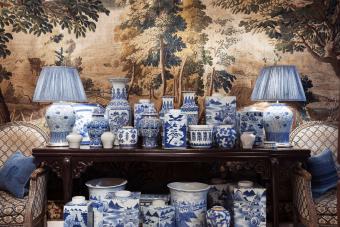
Your family heirlooms are more than just valuable antiques (or the junk your grandma wants you to keep). This is the kind of thing that provides a sense of family history as these items are passed down from one generation to the next.
Think about the items you've inherited from your parents, grandparents, and other relatives. If you're like us, these are some common family heirlooms you may have in your home.
With many products billed as "heirloom quality" or "heirloom material," it can be difficult to tell what is a real heirloom and what is simply a valuable object. The key difference is that heirlooms are intended to be handed down from one generation to the next. Although they are sometimes worth money, they don't have to have a lot of monetary value.
Family Jewelry
We're literally talking about "the family jewels" in the real sense of the phrase. Because it tends to be valuable, people often pass fine jewelry down to the next generation. However, you can also have heirloom costume jewelry that is pretty or sentimental but doesn't have a lot of monetary value. Either way, if you have antique lockets, rings, necklaces, brooches, earrings, or other items that belonged to generations past, you have a family heirloom.
Heirloom Art
That weird painting your great aunt left you? Yeah, it's technically an heirloom.
Sculptures, paintings, drawings, and other fine art pieces are also common heirlooms. If you look around your home and recognize art that hung or was displayed in your grandparents' or parents' homes, you have heirloom art. These pieces may be valuable, but they may also be sentimental. For instance, you could have a watercolor painted by your great grandmother. While it might not have a lot of monetary value, it is still an important heirloom.
Just because something is an heirloom, it doesn't mean you have to keep it. Like so many things in life, deciding what objects to hang on to is about finding a balance between your space, your own preferences, and the memories and associations you have. It's a personal decision with no clear right or wrong answer.
Clocks and Watches
It's also pretty common for families to pass down antique clocks and watches. These items have heirloom value for two primary reasons. First, they tend to be worth money, allowing them to become part of an inheritance. Second, timepieces often represent significant life events. Your grandfather may have received a Waltham pocket watch on his 21st birthday, for instance. Your great grandparents might have purchased a clock for their first anniversary. The timepieces and their stories become natural heirlooms.
Special Furniture
Another common heirloom is furniture. From blanket chests to dining tables, these pieces can be handed down, especially if they are high quality. These pieces don't have to be valuable antique furniture made by a famous brand. They can be a chair or bookcase made by your great grandfather. Look around your home for furniture given to you by generations past. If the piece is quality work and represents your family, it's an heirloom.
Sometimes, the furniture we inherit doesn't serve a purpose in today's world. If you get creative, you might be able to find a way to repurpose old furniture and give it a new and modern role.
Family Recipes

Although they rarely have any monetary value, recipes are definitely family heirlooms. Do you have the recipe for your grandmother's biscuits or your great aunt's famous lemon pie? These are items passed down to you, and they are special. Food has an important role in every family, and the recipes from generations past are heirlooms.
Photographs, Letters, and Journals
Photos, journals, letters, and other ephemera are another type of heirloom that isn't necessarily worth a lot of money but can be extremely valuable to families. If you have a box of old pictures or a packet of letters or newspaper clippings, you have an heirloom. You can learn how to date old photographs and other paper mementos and find out about your family history.
Quilts and Vintage Textiles
Quilts and other vintage textiles are another type of family heirloom These handmade items are special because of the time and effort that went into them, and many women used to accumulate linens in a hope chest. The quality of the embroidery and sewing in these items can be exceptional, and many families pass them down from one generation to the next.
Kitchen Items

Yulia Reznikov / Moment / Getty assorted vintage kitchen tools
While your grandmother's rolling pin may not be a valuable antique, it can still be an heirloom. Because food and food preparation are such an important part of family life, cooking items can become important objects within a family. You may have pots and pans, kitchen tools, canisters, and other pieces that belonged to past generations.
Firearms, Weapons, and Sporting Goods
Guns, swords, and other weapons can be valuable, both monetarily and sentimentally. These items, as well as sporting goods like fishing poles and canoes, can be passed down from great grandparents or other relatives. Whether or not the item has monetary value, it's an important part of your family's story. Sometimes, a piece like this may have a military history associated with it.
Books and Bibles
Old books can be family heirlooms too. From literary texts to special cookbooks, these bound volumes tend to be well-preserved and easy to pass down through the years. Family Bibles, in particular, are important heirlooms, since many contain a page at the beginning for recording births and deaths in the family. These become important resources for tracing your family history.
Musical Instruments
You may also have musical instruments, like fiddles, flutes, horns, and other items, that are family heirlooms. These pieces, which may have made music in the hands of your great, great grandparents, are important and meaningful as heirlooms. Some have monetary value, especially if they were made by certain manufacturers, but more often, most of the value is sentimental.
Fine China and Pottery

Because it is fragile and cared for gently, fine china can survive for generations. You may have your great grandmother's wedding china in your china cabinet or simply a piece or two of art pottery your aunt collected. These pieces may make an appearance at holiday meals, but they generally don't see regular use. This helps them remain in good condition so they can be passed down.
Related: 10 Valuable Antique China Patterns & Tips to Spot Them
Wedding Gowns and Other Special Clothing
Heirlooms can also be clothing associated with special events or pieces that are exceptionally fine or well made. Do you have your grandmother's fur coat? What about a wedding dress that belonged to someone in your family? These items have an important history, and that makes them heirlooms. Many people have boxes with special pieces like christening gowns, embroidered shawls, and other items.
Crystal and Glassware

Like china, crystal and glassware pieces tend to survive the years well because they are used infrequently. Whether you have your mother's Waterford crystal or a collection of Depression glass from your great aunt, these items are heirlooms too. Very old or special pieces can be worth money, but sometimes, the value is simply the family history associated with the piece.
Sterling Silver
You may also have sterling silver flatware, serving pieces, and other items that belonged to past generations. Because silver is inherently valuable, these items tend to travel down through the generations in a family. Some are exceptionally beautiful and well made, and antique sterling flatware can be much more valuable than its silver content. Some silver patterns are very rare. If you have antique silver, it's almost certain to be an heirloom.
Heirlooms Are About Stories
The truth is, any object can become a family heirloom if you pass it down to the next generation. The key is making sure the story of the piece is associated with the item itself. Take some time to write down your family history or draw a family tree, mentioning the important objects that are part of that story. That way, generations in the future will instantly be able to identify that item as a family heirloom.





